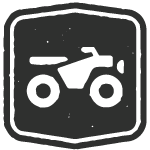

TRAVEL RESPONSIBLY
- Travel on designated roads, trails or areas.
- Comply with all signs and respect barriers.
- Drive over, not around obstacles to avoid widening the trail.
- Always practice minimum impact travel techniques for your mode of transportation.
- Travel with a group of two or more vehicles. Driving solo can leave you vulnerable if you have an accident or breakdown. Designate meeting areas in case of separation.
- Cross streams only at designated fording points, where the road crosses the stream.
- When possible, avoid mud. In soft terrain, go easy on the gas to avoid wheel spin, which can cause rutting.
- Don’t turn around on narrow roads, steep terrain or unstable ground. Back up until you find a safe place to turn around. For your safety, travel straight up or down hills.
- Stop frequently and scout ahead on foot. To help with traction, balance your load and lower tire pressure (typically not less than 20 pounds).
- Know where the differential or the lowest point on your vehicle is. This will help in negotiating terrain and prevent vehicle damage resulting in oil and fluid spills on the trail.
- Maintain a reasonable distance between vehicles.
- Choose the appropriate winch for your vehicle size.
- When winching always inspect your equipment, use the right winch for the situation, find a good secure anchor and never winch with less than five wraps of wire rope around the drum.
- Attach towing cable, tree strap, or chain as low as possible to the object being winched. Let the winch do the work; never drive the winch.
- When using a tree as an anchor, use a wide tree strap to avoid damaging the trunk of the tree
RESPECT THE RIGHTS OF OTHERS
- Respect the rights of others, including private property owners, all recreational trail users, and others so they can enjoy their recreational activities undisturbed.
- Be considerate of others on the road or trail. Learn the basics of trail etiquette.
- Leave gates as you find them. If crossing private property, be sure to ask permission from the landowner(s).
- Keep the noise and dust down.
- Be considerate of other campers’ privacy, keep your distance and avoid traveling through their campsites.
- Yield the right of way to those passing you traveling uphill. Yield to mountain bikers, hikers and horses.
- When encountering horses on the trail, move to the side of the trail, stop, turn off your engine, and speak—you want the horse to know you are human. Ask the rider the best way to proceed.
- Proceed with caution around horses and pack animals. Sudden, unfamiliar activity may spook animals—possibly causing injury to animals, handlers and others on the trail.
- Do not idly ride around in camping, picnicking, trailhead or residential areas.
- Keep speeds low around crowds and in camping areas.
- Camping supplies in natural colors blend with natural surroundings and are less intrusive to other campers’ experiences.
- Keep noise to a minimum especially in the early morning and evening hours.
EDUCATE YOURSELF
- Educate yourself prior to your trip by obtaining travel maps and regulations from public agencies, planning for your trip, taking recreation skills classes and knowing how to operate your equipment safely.
- Obtain a map, (motor vehicle use map where appropriate) of your destination and determine which areas are open to off-highway vehicles.
- Make a realistic plan and stick to it. Always tell someone of your travel plans.
- Check the weather forecast before you go. Prepare for the unexpected by packing necessary emergency items.
- Make sure your vehicle is mechanically up to task. Be prepared with tools, supplies, spares and a spill kit for trailside repairs
- Prepare for the unexpected by packing emergency items.
- Buckle up! Seat belts are mandatory. Know your limitations. Watch your time, your fuel and your energy.
- Take an off-highway drivers course to learn more about negotiating terrain in a four-wheel drive vehicle.
- Contact the land manager for area restrictions, closures and permit requirements.
AVOID SENSITIVE AREAS
- Avoid sensitive areas such as meadows, lake shores, wetlands and streams. Stay on designated routes.
- Other sensitive habitats to avoid include living desert soils, tundra, and seasonal nesting or breeding areas.
- Do not disturb historical, archeological or paleontological sites.
- Avoid “spooking” livestock and wildlife you encounter and keep your distance.
- Motorized and mechanized vehicles are not allowed in designated Wilderness Areas. (What are Wilderness Areas?)
DO YOUR PART
- Do your part by modeling appropriate behavior, leaving the area better than you found it, properly disposing of waste, minimizing the use of fire, avoiding the spread of invasive species and restoring degraded areas.
- Carry a trash bag on your vehicle and pick up litter left by others.
- Pack out what you pack in. Practice minimum impact camping by using established sites, camping 200 feet from water resources and trails.
- Observe proper sanitary waste disposal or pack your waste out.
- Observe all fire restrictions. If you must build a fire, use existing fire rings, build a mound fire or use a fire pan. For campfires, use only fallen timber. Gather firewood well away from your camp. Do not cut standing trees. Let your fire burn down to a fine ash.
- Ensure your fire is completely extinguished.
- Protect the soundscape by preventing unnecessary noise created by a poorly tuned vehicle or revving your engine.
- Before and after a ride, wash your vehicle to reduce the spread of invasive species.
- Build a trail community. Get to know other types of recreationists that share your favorite trail. Camp at least 200 feet from water and other campsites.
- In backcountry areas not open to vehicles, camp at least 200 feet from trails.
- For cooking, use a camp stove. They are always preferable to a campfire in terms of impact on the land.
- Do not wash in streams and lakes. Detergents, toothpaste and soap harm fish and other aquatic life. Wash 200 feet away from streams and lakes. Scatter wash water so it filters through the soil.
- In areas without toilets, use a portable latrine if possible and pack out your waste, otherwise it’s necessary to bury your waste. Human waste should be disposed of in a shallow hole (6”-8” deep) at least 200 feet from water sources, campsites or trails. Cover and disguise the hole with natural materials. Pack out your toilet paper.
- High-use areas may have other restrictions so check with a land manager.
- Take a small bag and pack out your pet’s waste– especially in front-country areas or on or near trails or trailheads.















